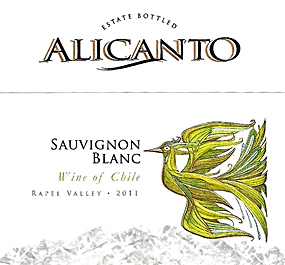I don’t know whether I’m getting a bit dyslexic in my advancing years, but I could have sworn the label on this week’s wines said “Alicante”. That’s the pleasant Spanish town on the Mediterranean, midway between the stately if slightly drab city of Murcia and the horrid, heaving sprawl of Benidorm.
A justifiable misreading of course, because Alicante is an important Spanish wine region which produces twelve million litres of decent wine every year.

But no, this is Alicanto: a trade name for a range of surprisingly good Chilean wines. You’ll spot the bottles easily, because there’s a very attractive picture of a slightly dotty-looking condor on the label. At least, I assume it’s a condor. I’m not very strong on birds.
Alicanto Sauvignon Blanc 2011 (white) Chile (Bt. 460 at Friendship, Best & Villa)
Now as you may know, the Sauvignon grape is rather a wild thing. It is known for its ability to produce sharp, lively wines with spiky acidity. Unlike Chardonnay with its aroma of buttery roundness, Sauvignon smells of grass, hay and green herbs. Some of them even smell of cat’s pee, which is considered a positive attribute among connoisseurs. I’ve tasted a lot of Sauvignons during the last few months but some of them were rather tame; the stuffing knocked out of them. Now I am for making a wine which is drinkable but not to the extent that the grape’s real character is lost in the process.
I’m telling you all this because the Alicanto Sauvignon Blanc is very true to form. The wine is a pale gold colour with greenish hues and a distinctive aroma of passion fruit and pomelo (that’s the green thing that looks like a cross between a lemon and an apple). You might be relieved (or disappointed) to discover that there’s no smell of cat pee, but there’s plenty of typical citrusy acidity. With lively fruit on the palate and plenty of zesty acidity, this is a light, very dry and refreshing young wine with a long and persistent finish. It would probably be at its best with food and would work well with many fish and chicken dishes.
Alicanto Merlot 2010 (red) Chile (Bt. 460 at Friendship, Best & Villa)
Here’s another excellent wine that’s true to the grape. Like the Sauvignon Blanc, it was vinified in stainless steel to preserve the essential quality of the grape. The wine is a dark brooding red, with hints of violet. Despite the ominous dark colour the aroma comes out soft and delicate. You’ll probably pick up the red berry fruit first with hints of raspberry and strawberry, followed by that characteristic Merlot aroma; a kind of forest floor earthiness and woodland brambles. I could almost smell the badgers (Are you really sure about the badgers? – Ed.) On second thoughts, perhaps I was getting a bit over-imaginative about the badgers and to be honest, I am not entirely sure what a badger smells like. But there are definitely woodland aromas there. You might even pick up a faint smell of cherries and vanilla.
The wine has a very soft mouth-feel with the red berry fruit up front. It’s a lovely dry, medium-to-full bodied wine; soft and subtle tannins and a very long earthy finish. The “body” of a wine is not easy to describe but roughly it means how “heavy” the wine feels in your mouth. Light-bodied wines are the ones you can knock back easily, whereas heavier-bodied wines seem to coat the inside of your mouth and demand your attention; they seem to feel thicker. It’s a bit like the difference in texture between fat-free milk and whole milk. If we think of wine body on a scale from one to ten (with ten being the heaviest and fullest) this would probably come in at about seven.
In many ways this is an excellent example of a Chilean Merlot. It has an alcohol content of 14% and the pleasing edge to the taste, which makes me feel that it would make a good partner for pasta, especially with a rich sauce.
Oh yes, talking of dyslexia, Woody Allen once quipped that he didn’t realise he was dyslexic until he once went to an up-market toga party in New York, dressed as a goat.




